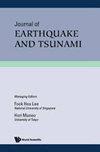用钾活化绿色混凝土技术增强外梁柱节点结构特性的新型延性
IF 2.1
4区 工程技术
Q2 GEOCHEMISTRY & GEOPHYSICS
引用次数: 0
摘要
在地震易发区,梁柱节点的延性和耗能能力是决定整个结构稳定性的两个突出特征。本文研究了低频循环荷载作用下钾活化地聚合物混凝土在外梁柱节点中的应用效果。利用有限元软件Abaqus进行了数值分析,并与实验结果进行了比较。从荷载变形关系出发,从延性、刚度退化、耗能能力、漂移比、开裂模式等方面进行了参数化研究。采用钾活化地聚合物技术在外梁柱节点应用中,由于高分子钾离子的大量聚合作用,使外梁柱节点的延性、耗能能力比IS 13920确认的常规特殊围筋水泥钢筋混凝土梁柱节点的极限承载能力提高了1.05%。在位移比增大11.96%的情况下,钾基地聚合物试件的耗能能力比普通钢筋混凝土试件提高2.78%,非结构裂缝数量减少,变形量增加11.26%。从观察结果可以看出,在梁柱节点中实施钾活化绿色聚合物技术,增强了延性,保护了结构在地震环境下的脆弱性,形成了一种创新、经济、可持续的抗震建筑施工模式。本文章由计算机程序翻译,如有差异,请以英文原文为准。
Novel Ductile Enhancement in the Structural Characteristics of External Beam Column Joint with Potassium-Activated Green Concrete Technology
Ductility and energy dissipation capacity of the beam column joints are the two prominent characteristics which govern the stability of the entire structure constructed in the seismic prone areas. In this paper, the effect of potassium-activated geopolymer concrete in the exterior beam column joint application is investigated under low frequency cyclic loading. Numerical analysis has been done by using the finite element software Abaqus and compared with the experimental work. From the load deformation relationship, parametric studies are carried out in the aspects of ductility, stiffness degradation, energy dissipation capacity, drift ratio and cracking pattern. The use of potassium-activated geopolymer technology in the exterior beam column joint application resulted in the improved ductility, energy dissipation capacity with superior ultimate load carrying capacity of 1.05% over conventional cement reinforced concrete beam column joints with special confining reinforcement confirmed by IS 13920 due to the enormous polymerization activated by high molecular potassium ions. There is an improved energy dissipation capacity of 2.78% of potassium-based geopolymer specimen resulting in lesser number of non-structural cracks and 11.26% more deformation under 11.96% enlarged drift ratio than the conventional reinforced concrete specimen. From the observed results, it is clearly noted that the implementation of potassium-activated green polymer technology in the beam column joints possessed enhanced ductility characteristics to protect the structure susceptible to seismic environment and resulted in innovative, economical and sustainable mode of seismic-resistant building construction.
求助全文
通过发布文献求助,成功后即可免费获取论文全文。
去求助
来源期刊

Journal of Earthquake and Tsunami
地学-地球化学与地球物理
CiteScore
2.60
自引率
13.30%
发文量
38
审稿时长
>12 weeks
期刊介绍:
Journal of Earthquake and Tsunami provides a common forum for scientists and engineers working in the areas of earthquakes and tsunamis to communicate and interact with one another and thereby enhance the opportunities for such cross-fertilization of ideas. The Journal publishes original papers pertaining to state-of-the-art research and development in Geological and Seismological Setting; Ground Motion, Site and Building Response; Tsunami Generation, Propagation, Damage and Mitigation, as well as Education and Risk Management following an earthquake or a tsunami.
We welcome papers in the following categories:
Geological and Seismological Aspects
Tectonics: (Geology - earth processes)
Fault processes and earthquake generation: seismology (earthquake processes)
Earthquake wave propagation: geophysics
Remote sensing
Earthquake Engineering
Geotechnical hazards and response
Effects on buildings and structures
Risk analysis and management
Retrofitting and remediation
Education and awareness
Material Behaviour
Soil
Reinforced concrete
Steel
Tsunamis
Tsunamigenic sources
Tsunami propagation: Physical oceanography
Run-up and damage: wave hydraulics.
 求助内容:
求助内容: 应助结果提醒方式:
应助结果提醒方式:


